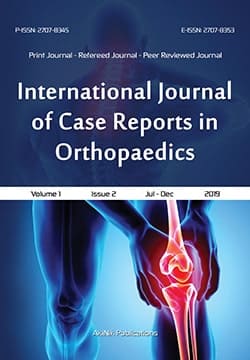Printed Journal | Refereed Journal | Peer Reviewed Journal
2021, Vol. 3, Issue 2, Part A
Treatment options for long-term damage of shoulder-girdle and rotator cuff muscles as illustrated by clinical cases
Author(s): Oleg Kaplunov, Sergey Demkin, Kamil Abdullaev, Kirill Kaplunov and Аnastasya Malyakina
Abstract: Introduction: The survey presents three clinical cases of successful treatment of chronic damage to the shoulder girdle and rotator cuff muscles with varying severity in people of working age. The patient with the most severe clinical symptoms of disorders had an episode of thromboembolism of the small pulmonary artery in past medical history. The aim of the study was to demonstrate, using the example of clinical cases, treatment options for patients with post-traumatic neuropathy of the axillary nerve associated with the rotator cuff damage, with improvement of the upper limb function and the patient's quality of life.Materials and Methods: A comprehensive study of the outpatient and inpatient records materials, the results of clinical laboratory methods of patient work-up was carried out, a selected conservative and surgical treatment, a rehabilitation program and drug prevention of thrombus formation are described in detail. Results: 8 months after the end of treatment, there was general, significant improvement of the damaged shoulder joint and limb function in all patients, and in the first two cases with moderate and medium deficiency, the level of complete recovery was almost achieved. The third patient, with the most adverse consequences and hemostatic comorbid pathology, underwent multi-team muscle-fascial transfer. As a result, there was a significant improvement in the right shoulder function. Discussion: A personalized approach to the choice of treatment tactics, depending on the degree of existing clinical disorders, whether a complex conservative treatment solely, or combined with an arthroscopic technique, as well as a reasonable implementation of techniques for transfer of preserved muscles to replace the lost function of damaged muscles in the most complex case was a condition and guarantee for achieving significant progress in the patient’s anatomical and functional status. Nevertheless, it seems appropriate to carry out a further search for more rational technologies of restorative reconstruction for the disorders under consideration. Conclusion: An individualized tactical and technical approach to the rehabilitation of such a complicated cohort of patients, correctly selected, taking into account the clinical and instrumental data, allows to improve the upper limb function of and the patients’ quality of life, and the reasonable tactics of clotting prevention ensures hemostasis control and the absence of vascular catastrophes.
DOI: 10.22271/27078345.2021.v3.i1b.59
Pages: 07-13 | Views: 905 | Downloads: 363
Download Full Article: Click Here
How to cite this article:
Oleg Kaplunov, Sergey Demkin, Kamil Abdullaev, Kirill Kaplunov, Аnastasya Malyakina. Treatment options for long-term damage of shoulder-girdle and rotator cuff muscles as illustrated by clinical cases. Int J Case Rep Orthop 2021;3(2):07-13. DOI: 10.22271/27078345.2021.v3.i1b.59







